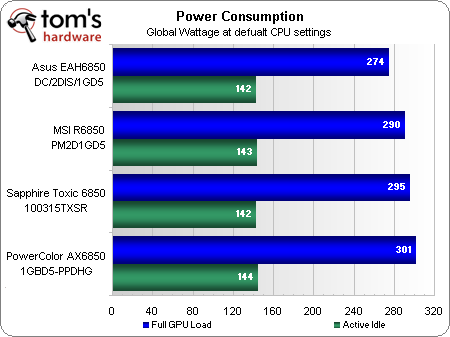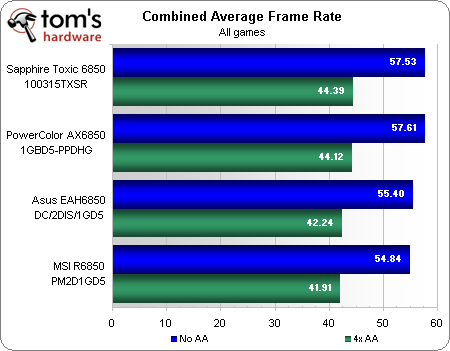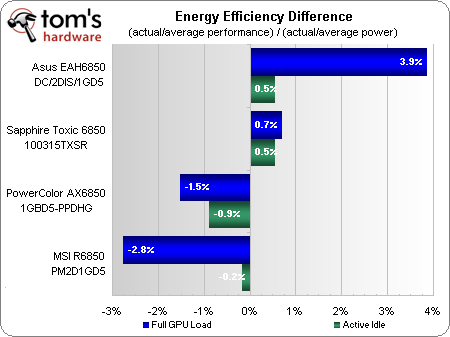Roundup: Four Radeon HD 6850 1 GB Cards Compared
Improvements to performance, acoustics, and bundles can add big value once a reference graphics card is modified by third-party vendors. We compare four modified Radeon HD 6850 1 GB boards to find out which company's additions best suit your gaming needs.
Power And Efficiency
Voltage and clock speed have adverse effects on power consumption, so we expect the fastest cards to fall to the bottom of our power chart.
Asus has surprisingly low power consumption compared to MSI, and even the slightest power advantage for Sapphire’s oversized card surprises us when compared to PowerColor. We wonder why Sapphire needed to include two PCIe connectors?
Sapphire edges out PowerColor in average frame rate, but margins this small could be pure variance.
This is where our match gets tedious. We wanted to base our efficiency number purely on averages, so we first averaged the No AA and 4x AA average frame rates of each card. We then calculated a class average by averaging our list of averages. For those following along, the class average is 49.8 FPS.
Dividing each card’s average by the class average puts its performance level on a percent scale, where “zero difference” is actually 100% and the top cards are higher. Following the same procedure for Full Load and Idle power gives us a similar percent scale where the most miserly cards have the lowest score. Dividing those results gives use a calculation of efficiency, where class average is 100%.
Yet no electronic component is 100% efficient. We subtracted 1 from each card’s result to move the chart scale by 100%, focusing only on the differences in efficiency. Asus’ lower-power “mid-speed” card is 3.9% more efficient than the class average, while Sapphire’s moderate power consumption makes it the most efficient “fast” card.
Get Tom's Hardware's best news and in-depth reviews, straight to your inbox.
Current page: Power And Efficiency
Prev Page Benchmark Results: 3DMark Vantage Next Page Heat And Noise-
It would be nice to see overclocking results. I know the whole "results will vary" malarkey but still, it would be interesting to see things like the benefit (if any) to having two pci-e power connectors on the Sapphire card or how high you could take the ASUS card using the software that came with it. Oh, and also, can you use Afterburner with the Powercolor and Sapphire cards?Reply
-
Scanlia Oh, and also, can you use Afterburner with the Powercolor and Sapphire cards?Reply
I use afterburner with a Gigabyte Card, (Flashed to ASUS). Works fine. -
Crashman BillehBawbOh, and also, can you use Afterburner with the Powercolor and Sapphire cards?YesReply
-
scrumworks Why are you using catalyst 10.6 (drivers from june) instead of latest, quite long already available 10.11 or 10.10-beta with HD6800 support?Reply -
sudeshc love this card looking to buy it for my new build and would go for ASUS as i already own the game.Reply -
iam2thecrowe so, wheres the comparison between these cards and rival cards from nvidia??? using recent drivers?? and OC???!this doesnt really tell us anything except the performance is so close you may as well get the cheapest of the lot.Reply -
ATI driver support is a complete debacle. That's why this article uses stone age drivers (10.6)Reply
-
Crashman karma831No OCing?iam2thecroweso, wheres the comparison between these cards and rival cards from nvidia??? using recent drivers?? and OC???!this doesnt really tell us anything except the performance is so close you may as well get the cheapest of the lot.Er dude...Reply
http://www.tomshardware.com/reviews/radeon-hd-6870-radeon-hd-6850-barts,2776.html
The previous article, which answered all your questions a month ago, was linked numerous times in this article.



